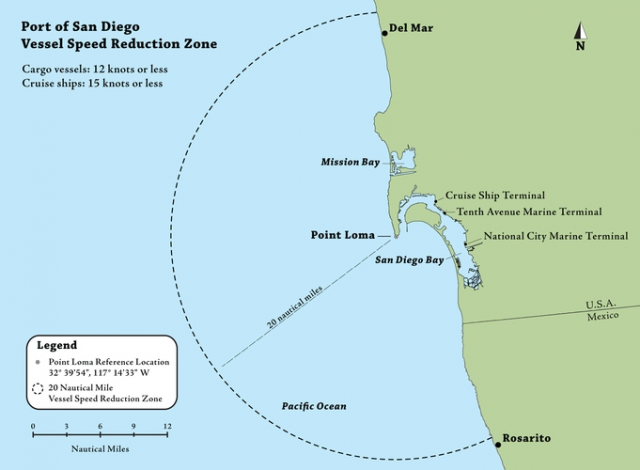Marine Vessel Speed Reduction Reduces Air Emissions and Fuel Usage
On this page:
- Overview
- How It Works
- Key Advantages of Vessel Speed Reduction
- Implementation Considerations
- Cost and Savings Components
Overview
Ocean-going vessels typically slow to their speeds within 10 nautical miles of a U.S. port. However, some ports have established larger vessel speed reduction (VSR) zones of up to 40 nautical miles. By reducing ship speeds VSR zones can reduce fuel consumption and emissions within the designated region. This strategy can be used for ports of any size and type, though larger ports that service higher-speed vessels would see the largest reduction in fuel consumption and emissions.
See the fact sheet on Port Operational Strategies: Vessel Speed Reduction (PDF) (March 2021, EPA-420-F-21-008)
VSR programs establish a zone around a port within which vessels operate at or below a designated speed, which may vary by vessel type. Ports such as Los Angeles, San Diego, and New York/New Jersey have established VSR zones ranging from 20 to 40 nautical miles, with speed limits between 10 and 15 knots.
Some ports encourage participation by providing financial incentives such as reduced berthing fees.
Key Advantages of Vessel Speed Reduction
- Reducing vessel speed decreases fuel consumption and engine emissions near port areas, which can improve the health of port workers and nearby communities (see example emission reduction calculations (PDF) (March 2021, EPA-420-F-21-008).
- Container and cruise ships, and roll-on/roll-off vessels achieve larger fuel and emissions benefits than smaller, slower-moving vessels such as bulkers, general cargo and tanker ships.
Implementation Considerations
- Slowing vessels near ports will increase transit times, although the short delays are generally within vessel arrival windows. Incentives could be established to offset vessel operator costs for any increase in transit times.
- Smaller ports are less likely to have professional staff equipped to reliably monitor participation.
- Local safety and navigation constraints may limit full VSR adoption.
Cost and Savings Components
- Capital costs should be limited to the purchase of vessel monitoring software to compile real-time AIS data.
- Operation costs may include:
- Labor for system administration (including communications, recordkeeping, and in-house monitoring of AIS data).
- Fees to external parties to monitor vessel traffic in lieu of in-house monitoring of AIS data.
- Fees for third parties to provide vessel and engine data for participating ships (used to calculate program emissions reductions).
- Labor and other nominal operating costs from increased vessel transit times.
- Financial incentives offered to vessel operators to encourage participation.
- Cost savings may be realized by vessel operators in the form of participation incentives and reduced fuel consumption.

